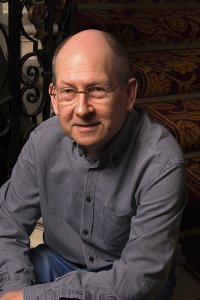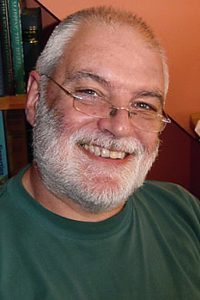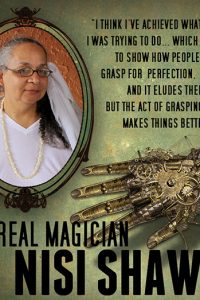Stephen Baxter: Conceptual Breakthrough
 Stephen Michael Baxter was born in Liverpool, England November 13, 1957, and received a mathematics degree from Cambridge in 1979. He earned a PhD in engineering from Southampton in 1983, and has worked as a math and physics teacher, an engineer, and an information technology specialist. Since 1995, he has been a full-time writer, and currently lives in Northumberland England with his wife, Sandra Shepherd, married 1987.Baxter’s early stories featured his Xeelee aliens, including first published story ‘‘The Xeelee Flower’’ (1987), novelette ‘‘Blue Shift’’ (finalist for a Writers of the Future Prize in 1989), and debut novel Raft (1991), first of five Xeelee Books including Timelike Infinity (1992), Flux (1993), Ring (1994), and the Philip K. Dick Award winning collection/fix-up Vacuum Diagrams (1997). His Xeelee-related Destiny’s Children series began in 2003 with Coalescent, followed by Exultant (2004), Transcendent (2005), and collection Resplendent (2006). He also published numerous Xeelee novellas, including Reality Dust (2000), Riding the Rock (2002), British Science Fiction Association Award winner Mayflower II (2004), Starfall (2009), and Gravity Dreams (2011).Baxter mainly writes hard SF on a variety of themes, including geological change, space exploration, and parallel universes. Standalone novels include alternate history Anti-Ice (1993); The Time Ships (1995, an authorized sequel to The Time Machine by H.G. Wells), winner of the John W. Campbell Memorial Award, the British SF Association Award, and the Philip K. Dick Award; Voyage (1996); Titan (1997); Moonseed (1998); Evolution (2002); YA The H-Bomb Girl (2007).His series include the Mammoth trilogy: Silverhair (1999), Longtusk (2000), and Icebones (2001), and the Manifold series: Time (1999), Space (2000), Origin (2001), and collection Phase Space (2002). His Time’s Tapestry sequence includes Emperor (2006), Conqueror (2007), Navigator (2007), and Weaver (2008), and he wrote a duology on climate change, Flood (2008) and Ark (2009). The Northland alternate history series is Stone Spring (2010), Bronze Summer (2011), and Iron Winter (2012). His newest solo series began with hard SF Proxima (2013) and will continue with Ultima (2014).Baxter is a prolific author of short fiction, with some of his work collected in Traces (1998), Phase Space (2002), and mixed fiction/non-fiction collection The Hunters of Pangaea (2004). His essays have been collected in Deep Future (2001) and Omegatropic (2001), and he wrote non-fiction Revolutions in the Earth (2003; in the US as Ages of Chaos). He wrote YA series novels The Web: Gulliverzone (1997) and The Web: Webcrash (1988), andDoctor Who novel The Wheel of Ice (2012).He collaborated with Arthur C. Clarke on The Light of Other Days (2000) and on the A Time Odyssey series: Time’s Eye (2004), Sunstorm (2005), and Firstborn (2007). More recently, he’s teamed up with Terry Pratchett for The Long Earth quintet, about journeys to alternate Earths, with The Long Earth (2012) and The Long War (2013) published and additional volumes forthcoming.
Stephen Michael Baxter was born in Liverpool, England November 13, 1957, and received a mathematics degree from Cambridge in 1979. He earned a PhD in engineering from Southampton in 1983, and has worked as a math and physics teacher, an engineer, and an information technology specialist. Since 1995, he has been a full-time writer, and currently lives in Northumberland England with his wife, Sandra Shepherd, married 1987.Baxter’s early stories featured his Xeelee aliens, including first published story ‘‘The Xeelee Flower’’ (1987), novelette ‘‘Blue Shift’’ (finalist for a Writers of the Future Prize in 1989), and debut novel Raft (1991), first of five Xeelee Books including Timelike Infinity (1992), Flux (1993), Ring (1994), and the Philip K. Dick Award winning collection/fix-up Vacuum Diagrams (1997). His Xeelee-related Destiny’s Children series began in 2003 with Coalescent, followed by Exultant (2004), Transcendent (2005), and collection Resplendent (2006). He also published numerous Xeelee novellas, including Reality Dust (2000), Riding the Rock (2002), British Science Fiction Association Award winner Mayflower II (2004), Starfall (2009), and Gravity Dreams (2011).Baxter mainly writes hard SF on a variety of themes, including geological change, space exploration, and parallel universes. Standalone novels include alternate history Anti-Ice (1993); The Time Ships (1995, an authorized sequel to The Time Machine by H.G. Wells), winner of the John W. Campbell Memorial Award, the British SF Association Award, and the Philip K. Dick Award; Voyage (1996); Titan (1997); Moonseed (1998); Evolution (2002); YA The H-Bomb Girl (2007).His series include the Mammoth trilogy: Silverhair (1999), Longtusk (2000), and Icebones (2001), and the Manifold series: Time (1999), Space (2000), Origin (2001), and collection Phase Space (2002). His Time’s Tapestry sequence includes Emperor (2006), Conqueror (2007), Navigator (2007), and Weaver (2008), and he wrote a duology on climate change, Flood (2008) and Ark (2009). The Northland alternate history series is Stone Spring (2010), Bronze Summer (2011), and Iron Winter (2012). His newest solo series began with hard SF Proxima (2013) and will continue with Ultima (2014).Baxter is a prolific author of short fiction, with some of his work collected in Traces (1998), Phase Space (2002), and mixed fiction/non-fiction collection The Hunters of Pangaea (2004). His essays have been collected in Deep Future (2001) and Omegatropic (2001), and he wrote non-fiction Revolutions in the Earth (2003; in the US as Ages of Chaos). He wrote YA series novels The Web: Gulliverzone (1997) and The Web: Webcrash (1988), andDoctor Who novel The Wheel of Ice (2012).He collaborated with Arthur C. Clarke on The Light of Other Days (2000) and on the A Time Odyssey series: Time’s Eye (2004), Sunstorm (2005), and Firstborn (2007). More recently, he’s teamed up with Terry Pratchett for The Long Earth quintet, about journeys to alternate Earths, with The Long Earth (2012) and The Long War (2013) published and additional volumes forthcoming.
Excerpts from the interview:
 ‘‘The way it happens is, I get bits of ideas, and then one of those ideas rises to the surface to become the seed of a novel. With Proxima, the big idea is the new planets. Astronomers have found a thousand new Earthlike planets orbiting other stars, and there are new theoretical models for the kinds of planets that might exist. One in particular is a habitable planet orbiting a dwarf star – I mean habitable for people like you and me, never mind some extremophile heat-loving bug. And because most of the stars in the universe are red dwarves, the sky is suddenly full of habitable planets again. It’s like 1940s SF all over again, when everyone was really optimistic about life in the universe, before they found out the moon was dry and Mars was a frozen desert – they imagined the sky was full of life.
‘‘The way it happens is, I get bits of ideas, and then one of those ideas rises to the surface to become the seed of a novel. With Proxima, the big idea is the new planets. Astronomers have found a thousand new Earthlike planets orbiting other stars, and there are new theoretical models for the kinds of planets that might exist. One in particular is a habitable planet orbiting a dwarf star – I mean habitable for people like you and me, never mind some extremophile heat-loving bug. And because most of the stars in the universe are red dwarves, the sky is suddenly full of habitable planets again. It’s like 1940s SF all over again, when everyone was really optimistic about life in the universe, before they found out the moon was dry and Mars was a frozen desert – they imagined the sky was full of life.
‘‘The other influence on Proxima was my thinking about the craft of writing SF in general. Working with Terry Pratchett on the Long Earth series has made me think harder about how ideas work, what tropes work, and how we put them all together.
‘‘My model here was Greg Bear’s Eon, particularly the first 100 pages or so, when they break into an asteroid that turns out to be hollow, which is surprising enough in itself, and then open a door, and another door, and another door, until they reach an corridor so long it won’t fit into the asteroid at all…. It’s a great sequence – a staggering piece of controlled wonder. I’ve been aiming for that deliberately with Proxima and Ultima, presenting a series of conceptual breakthroughs. I start with the colonization of a new planet, and there’s some worldbuilding, I have a life form that’s suited to the conditions present there – I had a lot of fun with that, and the readers have responded well. But at the end it’s all about conceptual breakthroughs. I brainstormed every gosh-wow moment I could think of, from Robinson Crusoe discovering his footprint on the beach to opening a door to find yourself in some alternate history.”
…
‘‘I see myself as revisiting old science fiction themes and techniques. And I do enjoy looking back at the genre’s past. One of my hobbies in recent years has been digging around in the old pulps. The British pulps especially, from after the war to about 1955. It was trashy stuff – sexy thrillers in France, detective stories and westerns – all written by old men in little towns in England! I followed one particular author whose tie-in novels I’d read as a kid, under a pseudonym. I traced him back and there he was, a war veteran writing stuff in the ’40s and ’50s, very anonymously. Many of the writers were ashamed of their profession because of obscenity trials! The work was definitely disreputable, if nothing else. Malcolm Edwards, my longtime editor, is a big fan of that kind of stuff as well.”
…
 ‘‘The Long Earth has eaten me up a bit, because we’ve agreed on a contract for five books now. At first we thought we’d do just one book, but the story was clearly too big for one book. The initial contract was for two books, but even there, it was still clearly too big. It’s a bit like my Xeelee universe: we can tell any kind of story we like in that setting. In fact, we can have any kind of Earth we like in there.
‘‘The Long Earth has eaten me up a bit, because we’ve agreed on a contract for five books now. At first we thought we’d do just one book, but the story was clearly too big for one book. The initial contract was for two books, but even there, it was still clearly too big. It’s a bit like my Xeelee universe: we can tell any kind of story we like in that setting. In fact, we can have any kind of Earth we like in there.
‘‘But Terry wants to end it on a James Blish note. He loves Blish, particularly the Cities in Flight sequence and the final novel, A Clash of Cymbals. He loves that – Mayor Amalfi, this practical guy, facing the end of the universe. Terry wants a big cosmic destination, so we’re working on that. I think in the end it’ll look as if the first two books are a two-part novel. Three and four set up this big climax in book five.”
…
‘‘In book three we go out to a quarter of a billion worlds. Two hundred and fifty million steps, when you’re getting to really strange stuff. Some of it is kind of logic from me, and some of it is more kind of fantasy from Terry.
‘‘And we also get into the physics. For me, with the Long Earth, it wasn’t like one of my regular ideas, where I usually start with the physics or ecology and work it through. This world was given to me by Terry, so it’s more like observation – I had to come up with a theory to fit the observed facts. I came up with some bonkers quantum mechanics stuff to explain the world, and bounced it off people like Ian Stewart, who’s very helpful. I’d been reading around about modern theories of multiple universes – very useful. In quantum mechanics, the world is supposedly splitting constantly into multiple copies – but maybe some of those copies can kind of braid into more coherent forms, so that you end up with a kind of tapestry of realities, like the Long Earth…. Multiple-universe ideas are all over modern physics. Some of these notions make specific predictions and are testable, but it’s really at the fringe of scientific thought.
‘‘I don’t think I believe any of it, though. The world just doesn’t feel like that. It doesn’t feel like you’re splitting into a million copies of yourself every second. I think reality’s a bit more robust. We’ll figure it out some day.’’






